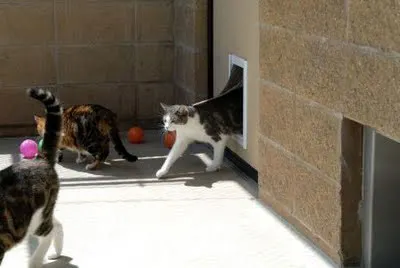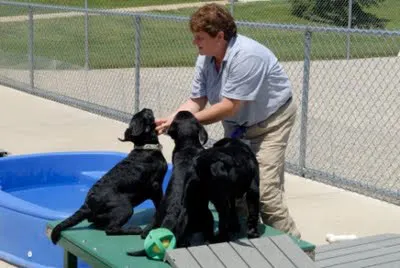 We’ve recently returned from a two-night trip to Dayton, Ohio to attend the “Behind the Paw” Pet Influencer Summit hosted by Iams and Eukanuba. A dozen bloggers from the US and Canada toured the Leipsic manufacturing plant, the Pet Care headquarters, and, what we want to discuss today, the Pet Health and Nutrition Center.
We’ve recently returned from a two-night trip to Dayton, Ohio to attend the “Behind the Paw” Pet Influencer Summit hosted by Iams and Eukanuba. A dozen bloggers from the US and Canada toured the Leipsic manufacturing plant, the Pet Care headquarters, and, what we want to discuss today, the Pet Health and Nutrition Center.
First, in the interest of full disclosure: Iams and Eukanuba paid for our transportation to Dayton, Ohio. They also paid for our rooms at the Drury Inn in Dayton. We were not paid for attending the summit and we are under no obligation to write about our experience.
The Pet Health and Nutrition Center is a research facility located about a two-hour drive from Dayton. Here over 700 dogs and cats reside and test the products that are part of the Iams and Eukanuba brands.
We have to confess we were apprehensive about visiting the facility. The use of the words animals and research in the same sentence brings many ugly pictures to mind. (And we have another post coming up regarding animal testing at P&G, the parent company of Iams and Eukanuba.)
The center is used exclusively for pet care research, specifically Iams and Eukanuba. (P&G also owns Natura foods.) These two brands are tested only at three locations:
- at this Pet Health and Nutrition Center
- at in-home trials with mostly local families
- at places where dogs are already living such as assistance dog training programs. We learned they work frequently with groups such as Canine Companions for Independence.
The testing at this facility is done because “every ingredient has a nutritional purpose,” according to Jason Taylor, who handles external relations for the pet brands. “We believe we need to prove that our products perform as they say they do.” Much of the testing done at the Center is “split-plate” testing, in other words, noting the animals’ food preferences.
The Center is home to a 50/50 mix of dogs and cats with about 700 animals on site at any time. The animals are housed at the center for the first half of their lives–when they are the truest test for dog and cat foods–and then placed in an adoption program to live out the second half of their lives in private homes. Animals go into the adoption program either because of their age (6-8 years for dogs, 8 years for cats) or because they aren’t doing well in a kennel environment.
Our first stop at the center was to meet Angela Morris of the company’s Office for Animal Welfare and Dr. Jessica Lockhart, animal behaviorist. Angela works to increase successful adoptions in the local area, and Dr. Lockhart’s job is to enhance the animals’ socialization and enrichment.
Each animal at the center is first given a “life plan”–a career plan for the animal’s work at the center and beyond, when the dog or cat will then be acclimated to life as a family pet.
According to Dr. Kerrie Wilson, one of two clinical veterinarians on staff, “We will not do anything on our animals that there isn’t a human equivalent for.” This means free-catch urine tests for cats (no “tapping” or aspirating the bladder to obtain urine). We’ll talk more about it on CatTipper this week but the center has constructed what they’ve nicknamed the million dollar litter box to collect the urine samples of the cat population. Dr. Wilson, who previously was a small pet veterinarian in private practice, said that in her three years at the center, muscle biopsies were performed only once. The animals were sedated and the vet made a one-inch incision and removed a piece of tissue the size of an eraser of a #2 pencil, procedures that are done on humans in clinical trials. “My definition of what we do here is we do anything a college kid would sign up for,” said Dr. Wilson.
After meeting with staff members, our next step (after sterilizing our hands and shoes so not to track in germs to the facility) was the Home Environment Room.
This room is set up much like a typical family room with couches, a TV, microwave, rolling office chair, baby crib, and other items that might be found in a home. The purpose? To teach dogs, as they approach their adoption date, home “manners.” To ensure a more successful adoption, staff members work on teaching dogs the skills they need to transition into a home environment–from not getting up on the sofas to not getting scared when popcorn is popped in the microwave.
Our next stop was the SPF (specific pathogen free) cat environment, one of few in the world. (We’ll talk more about the cat facility in CatTipper this coming week.)
 From there, we headed outside, passing a “catio” (more on that in CatTipper, too!), the puppy area, and finally heading to the North Campus of the facility to visit more cats as well as dogs.
From there, we headed outside, passing a “catio” (more on that in CatTipper, too!), the puppy area, and finally heading to the North Campus of the facility to visit more cats as well as dogs.
After donning protective booties and ensure cleanliness in the kennels, we headed in to visit some dogs: a kennel filled with black labs. The dogs were housed in four-foot-high kennels. Each was paired with another dog unless the dog was deemed to be happier as an “only dog” in his kennel. Each kennel had a special dog door developed here called a barn door that allowed the dog access to his outdoor run as the chose.
Several things struck us on the visit to this kennel:
- it was exceptionally clean. There was no odor, no mess, just a well-maintained kennel.
- the dogs were very well-behaved. Although filled with labs (and we know firsthand how much they like to bark), there was only moderate barking of a few dogs in greeting. Dogs ran up to the kennel door for some petting.
- every dog had a name and a collar. Specifics about the dog were noted on his kennel.
- the kennel design maintained a clear line of sight so dogs could see all the way to the other end, avoiding the phenomena of dogs barking at one end of the kennel and triggering the barking of other dogs who couldn’t see what was going on but just joined in. This was a great design.
- each dog had an elevated pet bed and a private area screened off by panels from the other kennels so they could avoid the gaze of other dogs if they chose.
- we saw many people interacting with the animals–taking dogs for walks, sitting in the sun brushing dogs, playing with the cats–while we were here. A large number of employees have the sole job of playing with the animals. Also, other employees can take part in the “Taking the Lead” program here and walk dogs on their lunch hour.
 We asked questions and learned several important facts about the dogs’ well-being:
We asked questions and learned several important facts about the dogs’ well-being:
- the kennel is heated to the comfort level of the dogs. It was warm to us but the temperature in the kennels was regulated at the dogs’ height, not at human height.
- the floor is heated at the dog door, but not at the other end of the kennel, so dogs can choose where they’d be most comfortable to lie.
- every day, dogs go to grassy playgrounds to play with other dogs.
- dogs are only contained in the indoor kennels during extreme weather conditions, otherwise they always have the option of going to their outdoor run.
- during a dog’s first year at the center, approximately $10,000 is spent on each dog including the purchase of the dog from a breeder, and training and socialization. Puppies spend four to six weeks going off site to people’s homes, local stores, parks, etc. during their developmental phase to lesson their fears and enhance socialization. Socialization continues throughout the dog’s stay at the center.
- the dogs all go through a training program using positive reinforcement techniques–punishment may never be used.
- all animals are spayed and neutered at six months old except for a colony of breeding cats.
- no procedures that are not necessary for the dog’s (or cat’s) health are permitted. There is no debarking, declawing, tail docking, ear cropping, etc.
So, what was our impression upon visiting the center? We left with–not a sense of depression (which, honestly, we expected)–but with ideas on how we could improve our own dogs’ and cats’ facilities by enriching their lives with better dog doors, more concern about the room temperature at their height rather than ours, and ways to provide outdoor access for cats (we’re about to build a “catio” for our cats–who live strictly indoors–upon seeing the amazing outdoor cat patios here so that the indoor cats can safely enjoy the outdoors.)
These are very much “working” dogs–like police dogs or military dogs. Of course, we’d like to see every dog cuddled up with his family on the couch watching TV at night–but we can say that every dog and cat we saw seemed very well cared for and happy. We saw no tail-chasing, fence-running behavior indicating a stressed dog. We saw no sad faces or dogs sitting in the back of their kennels like you might see at a shelter. What we saw were dogs accustomed to a routine and getting excited as play time approached.
In all, we felt these working dogs lived a comfortable life and were well-socialized with many opportunities for interaction with both humans and dogs. They had a much better setting than many family dogs we’ve seen who, in too many situations, sit outdoors hoping for a few minutes of attention from their family at the end of a busy day.
- Who are the Top Pet Influencers and Should Your Dog Join In the Fun? - April 10, 2024
- Should Dogs Sleep on the Bed? - April 9, 2024
- 10 Spring Cleaning Tasks for Dog Homes - April 9, 2024
